 By Pepper Parr By Pepper Parr
June 20, 2014
BURLINGTON, ON.
The jockey of course passed it on to the horse –and the horse told me.
This is that kind of a story because people want to spread the news around – but they don’t want to be the source.
We had occasion to talk to a Cabinet Minister from the region who assured us that this person (deliberately not using gender here) was back in the Cabinet of Ontario Premier Kathleen Wynne – but the member of the legislature wouldn’t say which portfolio – other than the person was very happy with what they had been given.
 Is this what Cabinet material looks like? word was the McMahon should not be counted out. We were discussing matters related to an issue germane to Burlington – the air park – what else – and mention was made of what role newly elected Burlington MPP Eleanor McMahan might play in the resolving of this issue.
We opined that while Ms McMahon has that incredible political pedigree with a Rolodex that is to die for, the fact is she doesn’t have any parliamentary experience and we don’t know if she will step up to and actually get over the bar. Her predecessor Jane McKenna certainly didn’t manage to make it.
Being a member of the legislature means being more than a pretty face – there is a thrust and cut to politics that is seen in the legislature. Is McMahon made of the “right stuff” and can she do it?
“I wouldn’t write her off quite that quickly” responded my contact. That got me sitting up in my chair real fast. Was I being telegraphed something? The Cabinet Minister I was talking to would be involved in the discussions as to who could and who should be in the Cabinet.
I pointed out that the area already had a Cabinet Minister in Ancaster – Dundas – Flamborough – Westdale and another in Oakville where Kevin Flynn serves as Minister of Labour. Would the Halton area qualify for three Cabinet posts? “The issue is not where the person comes from; the issue is what they bring to the table and the Premier has very high hopes for Eleanor McMahon. Remember the Premier recruited McMahon personally”, explained my source.
The Cabinet gets sworn in on Tuesday – we will be watching that broadcast quite a bit more closely. If anyone happens to see Eleanor out shopping for a new smartly cut suit – let us know. That would be a positive sign for sure.
 Premier Kathleen Wynne, Centre, knows how to wear an apron – we don’t know if she can bake an apple pie. we will know on Tuesday if she has chosen Burlington MPP Eleanor McMahon to be part of her cabinet. The Premier visited Burlington a number of times before the election was called and took part in several election events as well. During my first introduction to the Premier, during RibFest last summer when she was flipping racks of ribs along with Mayor Goldring and then chit chatting with people wearing a Rotary Rib Fest apron, I asked if she did much baking. She assured me she did and I wondered aloud if that was true. “Well I was baking pies just the other day” said the Premier and I suggested the next time she was in town she might bring me an apple she had made.
She promised she would do just that. I’ve not seen that apple pie yet – but if the Premier appoints Eleanor McMahon to her Cabinet all of Burlington will send her several bushels of some of the best apples the region grows.

 By Ray Rivers By Ray Rivers
June 20, 2104
BURLINGTON, ON.
It has taken him six years to finally announce his first concrete action to combat global climate change and it’s still only a little – and a little late. US President Obama’s Environmental Protection Agency has imposed a 30% carbon emission reduction limit on US coal-powered electricity plants by 2030. That will mean scrapping some of the older plants and conversion of many others to natural gas. In addition to the greenhouse gas (GHG) reduction benefits, this will also mean 6600 fewer premature deaths and 150,000 fewer asthma cases, they estimate.
By comparison, Ontario which historically burned coal for up to a quarter of its electrical needs, including at the largest coal-fired plant of its time, had completely shut down and banned coal burning earlier this year. Ontario’s courageous action is Canada’s single most significant greenhouse gas (GHG) reduction ever.
 Smokes stacks like this one dotted the province of Ontario. The government put an end to coal fired electrical generation plants – and we all breath easier now. The federal government had never really been supportive and had refused to help Ontario with costs of this shift away from coal. Nevertheless, Mr. Harper was only too proud to point out that Canada was already ahead of the US in cleaning up its coal-burning emissions, when Obama challenged him to follow the US regulatory lead. Canada’s share of emissions from coal burning are now only about a third of the equivalent in the US. But unlike the US, our overall GHG emissions are heading skywards making a mockery of Canada’s official reduction targets.
In any case, Obama wasn’t talking about coal, when he challenged our PM, he was referring to our oil sands. The oil industry claims they can now extract a barrel of oil from the sand without having to burn another full barrel in the process, but mining the tar sands is still the most inefficient and environmentally destructive resource extraction anywhere.
So Obama had the Keystone XL pipeline clearly in his sights. Approving Keystone would just enable further expansion of the oil sands, something US environmentalists have been decrying. And since American dependence on Canadian oil is declining thanks to horizontal hydraulic fracturing (fracking) in the US, that Keystone project is looking less and less likely everyday.
Harper and Obama are on different wavelengths. That became clear as our leader joined with the new Australian PM, recently, promising to thwart carbon pricing and other global attempts to mitigate the effects of climate change, and to oppose efforts such as Obama’s press for climate change through forums like the G20. Why should we expect dinosaurs to care about fossil fuels?
And Canada isn’t about to be lectured by a lame-duck president. Mr. Harper has another plan to get the bitumen out of Alberta and into Chinese and other export markets – its called the Northern Gateway project. Northern Gateway is a pipeline from the tar sands across fragile B.C. terrain, over a thousand kilometres, and to the environmentally sensitive Pacific coast at Kitimat B.C. Northern Gateway was Harper’s baby form its inception, and just this week he employed the pretense of an energy board review before approving its construction, as everyone was fully predicting he would.
Many Canadians are still unsure about what this means, but not the opposition parties which are united in promising to stop this risky business. Some pundits think this project could become the PM’s final undoing, since he may lose the crucial support of B.C. voters in next year’s federal election.
The B.C. aboriginal communities, over whose land the pipeline will cross and whose fisheries on the coast would be devastated by the inevitable oil spill, are also unified in their opposition. And the B.C. government still has conditions and concerns ranging from its desire for compensation to better environmental safeguards, before it consents. The province does not want to end up saddled with the clean-up costs of any spills.
B.C. residents take their environmental stewardship seriously. For example, B.C. and Quebec are the only Canadian provinces with carbon taxes to reduce fossil fuel burning and GHG emissions. And the B.C. economy depends heavily on tourism and its fisheries, both of which are threatened by this project. How is it fair that Alberta gets the royalties while B.C. gets the risk?
 All he costs related to the transportation of oil through a pipeline have to be taken into account – is that happening? Early cost estimates of the project which would move the half-million or so barrels of diluted bitumen a day through the Northern Gateway and onto foreign tankers could easily approach twenty billion dollars. Even if the proponent is in the private sector, there are always federal and provincial subsidies and all the ancillary costs attached to these kinds of mega projects. One could buy a lot of renewable energy infrastructure for that kind of money. And damage to the environment from a leak or shipping accident would be… well… just priceless.

Ray Rivers writes weekly on both federal and provincial politics, applying his more than 25 years as a federal bureaucrat to his thinking. Rivers was a candidate for provincial office in Burlington where he ran against Cam Jackson in 1995, the year Mike Harris and the Common Sense Revolution swept the province. He developed the current policy process for the Ontario Liberal Party.
Background links:
Ontario Coal Phase-Out Obama’s Plan Implications for Canada Canada’s Response US Health Benefits Northern Gateway
Canada-Australia Coalition Oil Sands Emissions – B.C. Carbon Tax

Ju ne 20, 2014 ne 20, 2014
BURLINGTON, ON.
James Burchill is not big on bureaucracy. He doesn’t like getting tangled up on loose ends. Define the target, aim, pull the trigger tends to be the Burchill modus operandi. Here he gets on about having permission to email people.
By James Burchill
Quick everyone … July 1st is fast approaching and we need to ask everyone we can think of whether we have permission to email them in the future.
Are you freaking kidding me?
Way to go genius … that’s going to cost you dearly.
Why?
Because YOU DON’T NEED TO ASK NOW IF YOU”VE EMAILED THEM BEFORE.
Implied permission is still a legit way to connect via email UNTIL JULY 1st 2017 that’s 3 YEARS FROM NOW!
You’re basically going to burn your email list if you approach things this way. If you ask everyone in a frantic rush for permission you will get maybe 10% say yes. The rest WILL NOT.
This is not news … it’s typically been this way in the past. If you try and get a list to give you consent to sell them stuff – they usual say no … about 9 out of 10 people do anyway.
So stop with the knee-jerk reactions and think this through. Sure, the days of spamming people are over. Nope you can’t rent a list and sell stuff to them post July 1st without getting some grief … millions of it if you’re found wanting!
But, if you have a list and have been emailing it for a while and you have a pre-existing relationship with people that PRE-DATES July 1st then you have 3 MORE YEARS to move from IMPLIED CONSENT to EXPLICIT CONSENT.
And guess what … there are many wrinkles in the “law” that need ironing out before the REAL DROP DEAD DATE of JULY 1ST 2017.
You do not need to be scaring, spooking or generally giving your list the option to tell you to “go away!” … and if you keep asking them, well it serves you right because they will tell you to ***** off!
Stop being such a “fraidy-cat” and man-up. Email permission is getting a face lift for sure, and you should NOT SPAM PEOPLE but you certainly don’t need to commit email suicide either. Begin slowly converting the implied to the explicit by offering them a valuable report or “ethical bribe” that helps them solve a problem you’re in the market to remedy. Then you are totally on side with Bill C-28 and can email all you like.
Why the rant today? Well I’ve seen so many emails begging me for permission to stay connected … are you kidding me? Get real. This approach is wrong and frankly sends out the worst kind of desperate signals to people. So when I got yet another “whiny … please can we stay friends …” type email I lost it.
All ranting aside, seriously … stop shooting yourself in the foot. Work to convert (implied consent) people on your list by emailing them converting (explicit) offers … and USE THE NEXT 3 YEARS TO DO IT!
Again to be clear … you have 3 years to convert implicit to explicit permission and frankly if you can’t figure out a cool way to do that within your business sector … well I’d say maybe you don’t deserve an email list.

James Burchill runs the Burlington Social Fusion Network that meets regularly at the Ivy Bar and Kitchen.

 By Pepper Parr By Pepper Parr
June 19, 2014
BURLINGTON, ON.
There will be phone calls from the city clerk’s office later today or early Friday when a surprising nomination in one of the city’s six wards gets filed. It will be a courtesy call advising a council member that there is now another candidate in the race.
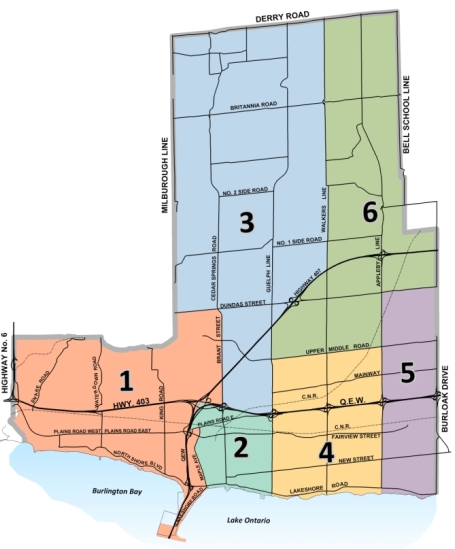 A new name will file nomination papers for one of the six wards later today or on Friday. This one should be a fun race. Should the new candidate win – it will certainly change the tone of this city council. A young at heart and very fit citizen with a strong business background and a number of years of community service experience will fill in the forms and pay the $100 fee and be in the race for a seat that some think can’t be won – but after watching 70 years of Tory blue ink slide of the Burlington map anything is possible.
It doesn’t look as if there is going to be a candidate to run against the Mayor; there are now more than six running against incumbent Blair Lancaster in ward 6.
Jack Dennison is back as a candidate in ward 4 – we will have something to say at a later date on the way his Ontario Municipal Board hearing has been handled.

 By Pepper Parr By Pepper Parr
June 18, 2014
BURLINGTON, ON
A more than 70 year run came to an end when Burlington elected Liberal Eleanor McMahon as their MPP. It was a solid win and part of a Liberal red sweep through much of the region.
Halton went Liberal after 19 years of Tory blue.
It was clear that the people of the province in general weren’t buying the Progressive Conservative line that the province had to cut like crazy to get the deficit in line and that 1 million jobs were going to suddenly appear.
The province decided to opt for hope and the belief that Kathleen Wynne could work through the problems. This despite the mistakes that can fairly be described a gargantuan under Dalton McGuinty’s leadership.
 The Liberals found a candidate with both depth and an ability to connect with people. Wynne managed to convince the voters that there was a lot of waste but that there would not be that kind of waste on her watch. She asked the people of the province to trust her and enough of them to give Wynne a majority government decided to do just that.
One of our readers had this to say about the McMahon win:
Congratulations to Eleanor McMahon. Clearly, she ran an effective campaign and I’m sure she’s was a qualified candidate. I do, however, find it extremely disheartening that Burlington residents bought into Liberal scare tactics, and were so willing to reward eleven years of cronyism, scandal, reckless spending, debt accumulation, blatant lying, shameless pandering to unions, and incompetence with their vote. The party’s victory begs the question, exactly how bad does a government’s behaviour need to be before they get the boot?
I’m curious what Wynne’s excuse will be when the books aren’t balanced by 2017/18 as promised, but I have no doubt she’ll come up with something!
A few days before the election Ms. McMahon and the Burlington Liberals tweeted out something about how they’ll be investing in local businesses and entrepreneurs. I’m still waiting for an answer regarding the specifics of how that will work. I know the Ontario Liberals will be handing out BILLIONS to Cisco and tens of millions to Open Text, but I haven’t heard one word about how Kathleen Wynne’s Liberals will help Burlington businesses succeed. I’m quite certain they won’t let them succeed TOO much, as corporate taxes are almost certain to be raised, as will personal income taxes on reasonably successful entrepreneurs.
Good luck Ms. McMahon. Your government has its work cut out for it, and we’ll be watching.
Indeed all of the province will be watching – many wish there had been better watching when Dalton McGuinty was leading that party.
Did Eleanor McMahon win – or did Jane McKenna lose and how did these two woman come to be the candidate for their political party of choice.
We are told that Kathleen Wynne recruited McMahon directly; that they lunched in Burlington and Wynne asked McMahon to accept the nomination.
The political tradition of this province has been for the local political party association to find a candidate and present that name to the party for vetting. The late John Boich spent many hours grooming Brian Heagle to become the Liberal candidate only to have Heagle decide that he was more of a blue blood than a Liberal and he went after the Tory nomination. Poor Heagle found that his blood wasn’t good enough and he couldn’t get the nod he needed from the Burlington Progressive Conservative Association.
 Karmel Sakran was selected by the Liberal riding association – not that it made a big enough difference. Boich convinced Karmel Sakran to run for office and he put up a good fight against a Tory who brought zilch to her nomination.
Jane McKenna was close to the last Tory nominated in the province in 2011 and despite no experience, other than a run against Rick Craven for the Ward 1 seat on city council – where she did very poorly, she had no experience.
 Turned out to take more than a good suit to convince the voters that you were able to do the job. She would appear at local events but never once made a delegation to city council where Councillor Craven remarked on the fact that the city had never heard from its MPP.
When Rick Wilson was doing great work to have a plaque placed on the waterfront that corrected the history surrounding what actually took place on our waterfront during the War of 1812 he found that he “blown off” by McKenna’s office when he put a call in to them for some help. At the time MP Mike Wallace was doing everything he could to get the plaque that is at Burlington Heights in Hamilton corrected but as Wallace said at the time: “it was a provincial matter and there wasn’t much I could do”.
The day the creation of the plaque was announced McKenna was on hand apologizing profusely to Wilson for the goof up at her office. Part of McKenna’s problem as an MPP was her inability to integrate into the community politically – she just didn’t have the experience and local Tory’s began to distance themselves from her.
You rarely saw Wallace and McKenna standing very close to each other when they were both at the same event.
There were serious problems with the local PC party association where it is reported the executive went through at least two changes. McKenna didn’t have good working relationships with her constituency executive. She had difficulty as well getting in on events when Cabinet ministers were in town.
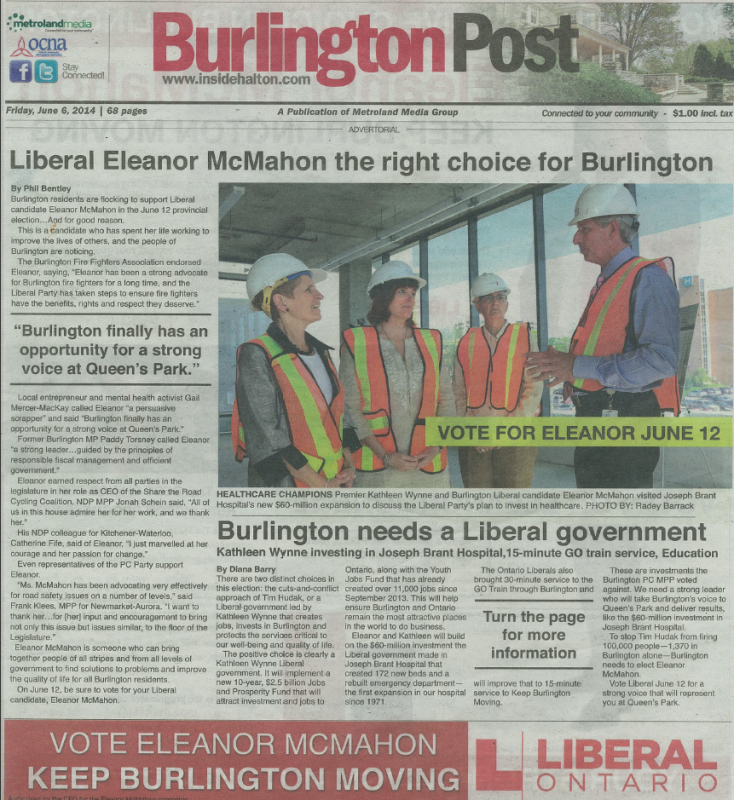 It was THE political coup of the provincial election when the Liberals managed to convince the Burlington Post to sell them a “mock” front page. Good for the revenue side of the business – but egg on the face editorially. The Post published a front page apology the following day. It happens. On one occasion when the city was officially opening the Community Garden in behind the Seniors’ Centre on New Street, McKenna wanted to be on hand and wasn’t able to get an official invite from the city. A polite call to the Mayor could have solved that problem. The Gazette wrote about the difficulty and advised McKenna on how she could have a presence at the event. At the time city hall talked the protocols they had to follow. It is an unhappy day when the political representative for a large number, probably a majority, of the people in the city cannot be at a socially and politically significant event. That was always McKenna’s dilemma.
The Burlington Progressive Conservative Association chose an unqualified person who was able to win the first time out because of the strength of the political base. The member was expected to perform and deliver for the community and that just didn’t happen.
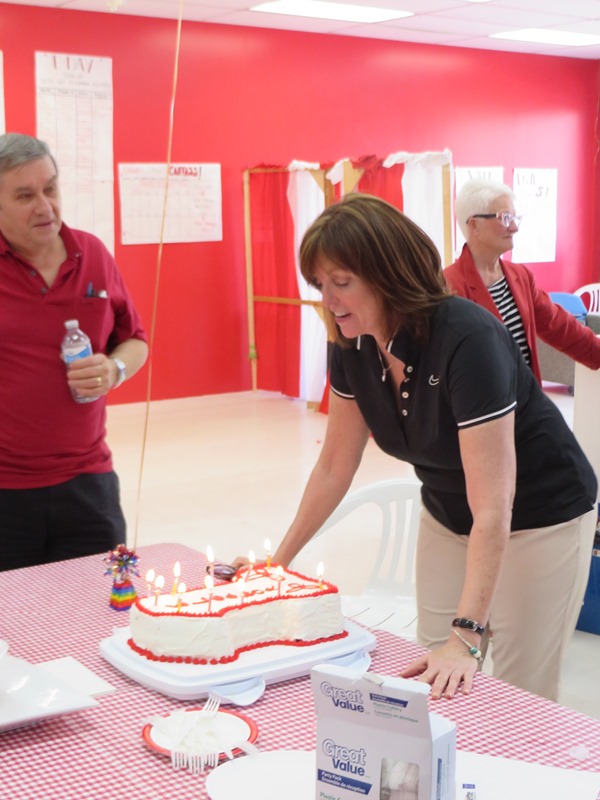 McMahon had a strong riding association that was able to get feet on the ground to do that vital door knocking – but the thinkers involved in the campaign all came from the Liberal party head office – Burlington was a seat they believed they could win. McMahon has a fine pedigree and her connections at the federal level are superb. She is on a first name basis with at least three former Prime Ministers and is a campaigner that connect with people easily. There is a humility to the woman who has core values that are more than admirable. There is nothing sleazy about the MPP for Burlington. Blessed with good health and a pleasant smile McMahon has leaned not to take herself too seriously.
She will use the next six months to get the feel of the provincial legislature and earn her stripes. By Spring of next year we will know if Eleanor McMahon is more than a pretty face.
Can she be the first in a 70 year line of Liberals for Burlington? Is there a Liberal sweep for Burlington at the federal level as well? Will the local Liberals manage to come up with a solid candidate on their own or will they have to rely on the party to sniff out a winner?

 By Pepper Parr By Pepper Parr
June 18th, 2014
BURLINGTON, ON.
The folks who lived close to the Burlington Air Park have learned to keep their eyes wide open and be ever vigilant. It was a call from a north Burlington resident that alerted us to the heavy truck traffic on Appleby Line that got the Gazette involved in this story that went from a delegation at city hall where the lawyer representing or speaking for the air park got turfed to the point where there was a Superior Court case which the city won and then an appeal of that case which the city also won.
Some people expect the Air Park to seek leave to appeal the latest court case to the Supreme Court of Canada. While the air park argument asking that the lower court ruling be set aside was decided faster than rabbits make bunnies there is some merit in taking this issue as far as it can go so that both the municipalities across the country can be certain just what authority they have on operations that are governed by federal legislation. The development industry has an interest in some clarification as well. Whether or not McMillan LLB or Peter E. J. Wells is the firm to take this any further is an interesting question that will get discussed by the downtown Toronto legal community at their favourite watering hole.
  Given not only the principles involved but also the amount of money on the table and a 200 acre piece of land – it is reasonable to conclude that this is far from over. Given not only the principles involved but also the amount of money on the table and a 200 acre piece of land – it is reasonable to conclude that this is far from over.
Everyone watches everything very closely. While the city waits to learn if there is another appeal – you can bet much more than your lunch money that the city and its legal counsel are looking at all the possibilities. The air park people are doing exactly the same thing.
Which is what made a real estate listing on Appleby Line more than just a sign on a lawn. A large property – 88 acres – was listed for a very healthy $7,880,000.The property is described as “near Highway 401- 407, which is true and with a picturesque view of the Escarpment. The listing goes on to say there are possible future developments.
This is north Burlington rural property and was the subject of a lot line adjustment application that was needed by Vince Rossi to expand one of his runways.
Expect someone to complain vociferously to the real estate bodies about what has been called by one Burlingtonian as false and misleading advertising.
The property is on protected, greenbelt land – zoned rural, rural residential, rural agricultural.
It is described as: Gated Luxury Custom Built Ranch Style Bungalow Featuring Approx. 9000 Sq Ft Of Living Space. High Quality Finishes With Detail. Blue Lagoon Salt- Water Pool.
Must be nice. Taxes were shown as $6,880,00

 By Pepper Parr By Pepper Parr
June 15, 2014
BURLINGTON, ON.
Like many good ideas – it starts out in a basement or someone’s garage and if it is right it grows from there.
The Burlington Chapter of 100 Women Who Care were meeting in a pretty drab looking community room at Tansley Wood and while the number of people involved was growing the rate of growth was a little disappointing.
Then out of the blue, BDO offered to cover the cost of a location that was certainly higher up the food chain. The June 18, 2014, from 7:30 – 8:30 p.m. will be held at the Burlington Golf & Country Club at 422 North Shore Blvd. E., Burlington.
BDO is the fifth largest single national accounting and advisory partnership in Canada with over 100 offices nationwide. It is a member of BDO International Limited, a UK company. The offer to pay for the Golf and Country Club space makes for a much nicer setting.
Marion Goard, one of the Burlington Chapter’s founding members announced that another local business – Dermetics, a firm that offers medical, surgical and cosmetic dermatology services had stepped up and gotten involved.
The Dermetics support is unique and solves a problem that many small local firms have when deciding where and how to support the community. “The office manager at Dermetics” explained Goard, “reached out to me with an offer to support 100 Women. The rationale behind this is that they receive a fair number of requests for support from various sources and have a tough time determining who to support. By being involved with us, they know that their financial contribution is going to great causes, is being spread out across the city and they get their staff involved.
 Dermetics registered 10 memberships with Woman Who Care. This allows 10 of their staff to attend the meetings where they participate fully – as if they were funding their donation themselves however Dermetics will write the cheque to the recipient organization. Dermetics registered 10 memberships with Woman Who Care. This allows 10 of their staff to attend the meetings where they participate fully – as if they were funding their donation themselves however Dermetics will write the cheque to the recipient organization.
This is something a number of organizations might find very useful – it allows the company to support the community without tying up staff in the selection process. It also lets staff attend the meeting and be part of that selection process. It will be interesting to see if anyone else picks up on this.
The 100 Women Who Care model has its roots in the United States with several chapters forming across the U.S. and Canada since 2006. The mandate of the group is simple: 100 women or more meet four times a year to choose from three charities nominated for consideration. Members cast their ballot and then each write a $100 cheque for the charity that gets the winning vote. The goal is to raise a minimum of $40,000 annually ($10,000 x 4 meetings) in support of local initiatives.
The Burlington Chapter, founded by Marion Goard, Pat Grant, Megan Teall and Laurel Hubber, held its first meeting at the beginning of this year raising more than $3,000 for the Burlington Humane Society. At their second meeting they raised $4,000 for Halton Women’s Place.
Part of the appeal of 100 Women Who Care is that at each meeting the beneficiary of the last donation has a chance to address the membership to thank the group and to share how the donation will have an immediate impact in our community. “On Wednesday, Kaitlin Gordon, Development Coordinator from Halton Women’s Place will share with us how our $4,000 donation is making a difference to women’s lives in Halton. After Ms Gordon’s presentation, our members will listen to three 5-minute presentations about three new charities, take a vote and make their donations to the chosen beneficiary immediately afterwards,” says Goard.
Heading into the third meeting, support for 100 Women Who Care Burlington continues to grow. “We always welcome individual members as well as businesses who wish to be corporate sponsors to join us at our June meeting,” says Goard. “And whether you are new to the group or are already a member, we’re sure everyone will be excited to see how a small group of women can make a difference in our community – in just one hour.”
You can RSVP your attendance to info@100womenwhocareburlington.com. Nominations for charities/organizations can be filled out online ahead of the meeting at Nominations will also be accepted the night of meeting.
Registration begins at 7:00 p.m., with the meeting starting promptly at 7:30 p.m.
Goard does point out that the Burlington Chapter has some catching up to do. “I learned that the Greater St. Johns March donation exceeded $29,000 and they have over 900 ‘Likes’ on their Facebook page. We definitely have a ways to go to keep up with them. I’m not sure what’s holding things back here.”
Maybe the Golf and Country setting will make the difference.

 By Staff By Staff
June 15, 2014
BURLINGTON, ON
They are relentless.
They send the emails out by the hundreds of thousands.
Their costs are minimal.
They need one of two things – people with more greed than common sense or people who don’t fully understand internet technology and what happens when they click on a link.
This is particularly difficult for seniors who can remember the day when they had phones run by a local operator who made the connections.
 If you click on that box your problems will have just begun. It means being vigilant – if it doesn’t seem right, it probably isn’t and if you don’t understand what you are being asked to do – then don’t do it. And if it sounds too good to be true – then it isn’t true.
Set out below is the most recent scam. We do not bank with CIBC. How the fraud artists got our email address is beyond me – it’s not hard to get. That address will get bundled with millions of others and sold to someone who will then use that list to send out millions of email – all they need is one and they make more money with that person than they make in a year.
Some people have been ruined because they clicked on what they saw as a great opportunity. For the fraud artist it was a great opportunity.

 By Ray Rivers By Ray Rivers
June 14, 2014
BURLINGTON, ON.
What a night; what an election! Ontario voters have rejected the roller coaster, recessionary, austerity program the opposition PC’s were promising. Instead we have bought into the hope, promise and reconstruction offered in the last provincial budget by Premier Kathleen Wynne. And the NDP, which had precipitated the election, ended up being marginalized.
 The promise was clear – not to see how well she delivers on that promise. PC leader Hudak also announced he was stepping down as leader, something which will be music to the ears of the growing number of Ontario conservatives who don’t share his ‘Tea Party north’ vision for this province. The Globe and Mail, which had been critical of Hudak’s ill-conceived election platform surprised many with its conditional endorsement of the PC leader (Tory minority). Reports indicate that the Editorial Board may have been coerced by the paper’s owners, apparently causing dissent among editorial board members and making a mockery of the claim of independence for ‘Canada’s so-called national newspaper’.
NDP leader Andrea Horwath needs to consider also stepping down, given her disappointing performance over the last year and during the campaign. Horwath falsely accused the Premier and her party of ‘corruption’. Then, having caused the election, she was inept at producing a credible platform of her own – leaving her fellow candidates and party supporters baffled and rebelling. What was clearly a cynical play to expand her party’s seat count failed miserably and cost us all – paying for an election we neither needed nor wanted.
By her unqualified victory last night Wynne has freed herself from the legacy of the McGuinty era scandals which had plagued her from her first day as Premier. Moreover she now has a mandate to lead the province onto the path she has promised would restore the provincial economy. And of course, she will need to grapple with the significant budgetary deficit still ahead as well as a debt-load inherited from the years past.
That will likely mean paying attention to the revenue side of the equation as well as the cost side. So Ontario residents should expect a return to a more equitable and fulsome taxation regime. The province has the most efficient (least cost) government in the country. So while she will need to consider ways to restrain the mushrooming size of government services, that alone will not be enough to remove us from the ‘have-not’ list of provinces.
There were other big changes in this election as well. Locally, Burlington, where I once ran, against the odds, finally went Liberal with Eleanor McMahon winning after 70 years of Tory dominance. Ted McMeekin, in Ancaster, Dundas, Flamborough and Westdale, retained his seat and can be expected to resume duties in Premier Wynne’s new Cabinet.
Halton voters put an end to the 20 years of Ted Chudleigh’s reign as Liberal Indira Naidoo-Harris pushed him out, convincingly. Chudleigh’s ouster represents the changing demographics of one of the fastest growing communities in Canada – one that he and his friend Mayor Gordon Kranz created. Can a similar fate be in the cards for Kranz this upcoming municipal election?
Premier Wynne has been given four years to implement her program of renewal and reconstruction for Ontario. This is an heroic undertaking given the global world we live in and the lack of support from a federal government best described as anti-Ontario. To be successful the Premier will need all of our support – after all we are all in this Ontario together.
Background links:
Voters Decide Liberal Win Wynne Settles the Debate Globe Editorial Board
 Ray Rivers writes weekly on both federal and provincial politics, applying his more than 25 years as a federal bureaucrat to his thinking. Rivers was a candidate for provincial office in Burlington where he ran against Cam Jackson in 1995, the year Mike Harris and the Common Sense Revolution swept the province. He developed the current policy process for the Ontario Liberal Party. Ray Rivers writes weekly on both federal and provincial politics, applying his more than 25 years as a federal bureaucrat to his thinking. Rivers was a candidate for provincial office in Burlington where he ran against Cam Jackson in 1995, the year Mike Harris and the Common Sense Revolution swept the province. He developed the current policy process for the Ontario Liberal Party.

 By Pepper Parr By Pepper Parr
June 13, 2014
BURLINGTON, ON.
Hello Burlington. An historical day for the city – you’ve elected a member of the provincial legislature from a different political party. Burlington is no longer Tory Blue. The earth did move. We know how it happened – the why might take a little bit of time to understand.
 Eleanor McMahon, MPP elect for Burlington  For Eleanor the world of politics wasn’t one of those “love at first sight things” She was given an opportunity to help out and found herself in a place where her mental and physical energy could be used. An Assumption High school student Eleanor went on to do an arts degree at the University of Windsor and spent a year in France doing graduate work. She has also done certificate programs at the University of Waterloo and Trent University. For Eleanor the world of politics wasn’t one of those “love at first sight things” She was given an opportunity to help out and found herself in a place where her mental and physical energy could be used. An Assumption High school student Eleanor went on to do an arts degree at the University of Windsor and spent a year in France doing graduate work. She has also done certificate programs at the University of Waterloo and Trent University.
Mom was a woman with a university education, far from common at that time. Her world was the laboratory where she worked at the thinking end of a microscope.
An opportunity to work in Ottawa came her way and as a shy, inquisitive 23 year old Eleanor headed for Parliament Hill and spent a number of years working with John Turner, who to this day is a close friend. McMahon worked for Jean Chretien and can recall going to more than one hockey game with the then Prime Minister.
Communications and strategy were the McMahon strengths; where she took the dictum that if you didn’t know your history you were bound to repeat it.
When McMahon was a high school student Model Parliaments were a part of the curriculum – that is probably where the high school baseball player got infected.
 Burlington can expect to hear a lot from this lady. Eleanor’s Dad served in the Canadian army taking part in several of the major campaigns in Holland and Italy. His leadership ability got him to the Royal Military Academy at Sandhurst, the British military leadership school that trained the men and woman who won the second world war.
Dad returned to Windsor after the war and began civilian life in the automotive sector where he handled what we today call logistics. Getting parts to where they were needed involved a lot of paper shuffling during that time when carbon paper was what you used to make a copy.
He worked with Chrysler and turned down several opportunities to move from Windsor and up the management ranks. Family was the core value and having everyone at the dinner table mattered most.
When it was suggested that the McMahon dinner table might resemble the television program Blue Bloods where several generations of NYPD officers shared a Sunday meal, McMahon nodded and said – that was pretty much who we were.
Conversation with McMahon is filled with some of the Liberal political greats – she would refer to John when she talked about John Turner or Jean when she talked about Primer Minister Chretien but it was always Mr. Gray when she talked about the late Herb Gray, probably her first and most influential mentor.
McMahon spent a considerable amount of time with the United Way in Ottawa and with Petro Canada where her communications skills were valued.
 Prior to being elected McMahon was the Executive Director of Share the Road, an advocacy organization that worked towards getting bicycles and car drivers to learn to share the road She took up the challenge and was in the race. The help that was needed from the Ontario Liberal party was delivered and the local riding association under the leadership of Roland Tanner got the troops into the trenches for a short but intensive campaign. It was something to watch the way McMahon bonded with people – I knew then that the woman as a natural, I also knew that this was Burlington and there was more than 70 years of history to overcome.
Saturday after Saturday the word would go out – “we are gathering at Tim Hortons” and working a particular part of the city. On some occasions McMahon had the Premier with her. McMahon was the better campaigner.
In the closing days of the campaign the McMahon campaign pulled off a coup that few expected possible in Burlington – they managed to buy the front page of the Burlington Post. While the advertisement was identified as an “advertorial” it looked like the real thing to a lot of people. That stiffened up the race and must have generated howls of disdain from the McKenna camp. It brought a front page apology from the Post to anyone offended by the advertisement. It was a sign as well of things to come: McMahon took 43.3 % of the vote a sold 5 points more than McKenna.
McMahon now has to build a solid Liberal constituency organization and create the relationships with the various organizations that she is now in place t represent at Queen’s Park.
It might take a bit of time for McMahon to bring about the change Burlington is going to have to adjust to – she will have her plate full with Chamber of Commerce and Rotary Club lunches that want to see the new member of the legislature.
Getting sworn in and learning the ropes at Queen’s Park will keep her busy during the summer and into the fall season.
Getting a grip on what the immediate, near term and long term issues are for Burlington will take time. There will be those who will want to create their own relationship with the member and determine how much influence they can have.
Eleanor McMahon knows the game of politics as well as anyone and brings an ethic and a set of personal values to public office this city has not seen in some time. She is in office for four years – time enough to show what she can do. The timber that makes up the back bone of this woman is the kind of wood cabinets are built with Not immediately – but in time Eleanor McMahon will serve as a member of cabinet. And we will be very very proud of her.
The day she stands in the legislature to give her maiden speech will be significant and filled with personal emotions. It was in that Legislature that Bill 126 “Ontario Road Safety Act” was passed. It became known as Greg’s Law, in memory of OPP Sergeant Greg Stobbart, Ms. McMahon’s husband, who was killed while on an off duty training ride on his bicycle on June 6, 2006 in Milton, Ontario just north of their home in Burlington.

 By Pepper Parr By Pepper Parr
June 12- 2014
BURLINGTON, ON.
The bigger picture of the Burlington Air Park Inc., appeal of a lower court decision is now becoming clearer.
There are losses and there are losses – this one was a trouncing.
In the Appeal Court process has each side giving oral arguments based on the documents that were prepared beforehand. That collection of documents is called a Factum.
The appellant, in this case the Burlington Air Park Inc., proceeds first. At any point during the oral arguments either of the three appeal court judges can intercede and ask questions.
Peter Wells spoke for more than two hours and delved into all the reasons why the lower court ruling, the one given by Justice Murray in Milton should not stand. They ranged from inter jurisdictional immunity to the argument that the court case was never about the content of the landfill – which came as a surprise to the 11 Burlingtonians in the court room.
One of the judges asked Wells if the air park could faithfully obey federal laws why could they not obey municipal laws?
Wells later said that Justice Murray misunderstood what the real issues were. Several in the court reported later they they believed this was the point at which Wells lost his case. Several of the observers felt Wells glossed over the environment issues and one appeal court judge asked Wells directly if he thought Justice Murray was wrong. Wells said he believed Justice Murray was wrong.
Prior to the hearing Burlington Air Park Inc., filed a motion to have new evidence submitted. The court accepted the new evidence and then asked Wells what any of this had to do with the Murray decision.
The new evidence was related to an action the city had brought against King Paving that was later dropped; discussions about King Paving being able to bid on future city contracts and the Pinchin Environmental report dated April 7, relating to a “groundwater monitoring program limited environmental site assessment. Terrapex is currently reviewing that report for the city. It is a very, very complex detailed report .
The judges didn’t see it as relevant.
They took another short break, returned to the courtroom and advised Mr. Wells that they were deciding to dismiss his appeal.
Ian Blue didn’t have to say a word. He didn’t have to defend his Factum. The appeal court judges didn’t see a case to be argued and everyone was dismissed. The moment the judges were out of the court room the Burlington crowd burst into spontaneous applause.
It was over
The justices also awarded the city $22,000 in costs. These court cases are fast becoming a profit centre for the city.
The city put out its press release saying the “Court of Appeal for Ontario has upheld the decision that the City of Burlington’s site alteration bylaw applies to the Burlington Executive Airport.
“The city’s bylaw is valid and binding on the Burlington Airpark and the city is able to enforce its bylaw.”
The Mayor is a happy camper: “The city has shown its commitment to the residents of Burlington in keeping the site alteration bylaw in effect, even in challenging circumstances. He congratulated city staff who persevered in doing the right thing for our residents in ensuring that fill does not continue to pile up on the site and that there are some controls in place to help our community when affected by operations such as the airpark.”
Many of those residents are wondering why the land fill was allowed on the site in the first place.
Ward 6 Councillor Blair Lancaster, who has had her problems with the residents directly impacted by the land fill dumping, said “I am pleased for the people who live near the Burlington Airpark that this decision has been upheld by the Court of Appeal. This is an important moment for those residents, and I am hopeful that things will improve for them.”
The city will meet with legal counsel to determine next steps.
The site alteration bylaw allows the city to regulate how a piece of land can be altered, such as through filling, grading or excavation. The city is updating its site alteration bylaw, which regulates how a piece of land can be altered through filling, grading or excavation, and is hosting a public information meeting to review the new version on Thursday, June 19 from 7 to 9 p.m. at City Hall, 426 Brant St., Room 247.
The really critical question is – which version of the bylaw will be used to bring the air park to heel – and are we done with the appeals?
Barbara Sheldon, who has suffered the most damage at this point – but there are neighbouring farms that will not know for years if they will suffer damages and who knows when whatever is in that fill is going to work its way into the water table, has become the “poster girl” for the movement opposed to the air park work. She has done a CBC News interview as well as a CFRB radio interview and is seldom at a loss for words had this to say about the appeal dismissal: “The verdict of the Appellate Judges, upholding Justice Murray’s ruling that the City can enforce its site alteration by-laws, may be the first, real turning point to the restoration of the properties and lives that Rossi has willfully and deliberately damaged since he bought the Airpark.
“Unfortunately, Mr. Rossi’s proven history with this community has destroyed any possible belief from me that Mr. Rossi will ever comply with the City or respect his neighbors.
“What I do have hope for, is that the pilots will now take back their ‘club’ and restore it to the wonderful, recreational airpark that was built and operated for 60+ years by the Kovachiks’, and that it once again co-exists in harmony within the community and the City of Burlington, as it did under their ownership.”
Vince Rossi does not make himself available to the Gazette. He is currently suing this newspaper on a web site along with two north Burlington residents for damaging his reputation and has asked the court to award him $100,000 in exemplary damages.
Defences are being prepared – a court date has yet to be determined.
Rossi said he will be meeting with his legal team to determine how to proceed with the planned expansion of the air park. He apparently expressed hopes that the city ““might be more conciliatory.” Rossi is reported to have said: “We’ve been conciliatory with the city all along up until this recent situation. It’s not like we did anything the city was not aware of.”
 City general manager Scott Stewart talks to members of the Rural Burlington Greenbelt Coalition during a council meeting break. On the far right sits Monte Dennis, of of the people being sued by the air park; in the row behind sits Vanessa Warren who is also one of the defendants in the libel suit with the air park. On the left, standing is Blake Hurley, the city legal staffer who handed the air park file for the city. Seated on the left is Ian Blue the lawyer who has done some very good work for the city. Vanessa Warren, founder of the Rural Burlington Greenbelt Coalition and a candidate for the ward 6 council seat in the October municipal election, hopes that this decision will open up the blockages on getting environmentally based information from the province and that the Ministry of the Environment might soon be able to go on site and test the soil “which is the problem.”.
 Vince Rossi, president of the Burlington Executive Air Park and believed to be the sole shareholder of the private company, met with north Burlington residents. He took all the comments made “under advisement”.. Right now the city and the MOE are battling over Freedom of Information FOI requests that have been made and denied. They city is either at the mediation or adjudication level on several of these FOI requests.
Where is all this going? It probably isn’t over yet. The air park has a very significant $4.5 million investment and they aren’t just going to walk away from it.
Ideally for the community the land fill will eventually get tested – and if it found to be damaging – then it has to come out.
Who pays for that? The people who own the land. Right now Vince Rossi own the air park and no one can see his bank foreclosing on the mortgage they hold – they don’t want title to the land.
There is a 200 acre piece of prime land up there – at some point someone is going to have to come up with an idea for the property. Vince Rossi believed he had a great idea but he has not managed to sell that idea to anyone.
Don’t expect any innovative ideas from the council you are going to elect in October

 By Pepper Parr By Pepper Parr
June 12, 2014
BURLINGTON, ON.
It was a healthy crowd. They were attentive and at Nelson High to listen to a debate between Progressive Conservative incumbent Jane McKenna, Liberal candidate Eleanor McMahon in and Janet Mowbray representing the NDP. All want to be elected as the Burlington representative in the provincial legislature.
Other than the debate sponsored by the Canadian Federation of University Women, debate this turned out to be the only opportunity to see the candidates debating
The audience was attentive with the focus on what each political party would do for the province in terms of education.
The lines between the policies were as clear as any citizen could possibly want them to be. The Progressive Conservatives were blunt – they want to see 100,000 fewer civil servants on the public payroll which meant cuts at the educational, medical and public services levels. While cutting in these sectors was to be brutal – the promise was to create 1 million new jobs in the private sector.
The issue for the PC’s was the level of debt the province is carrying. The Liberals weren’t as constrained with debt – they saw debt as what was needed to fully recover from the 2008 recession.
The differences in the political party decisions are fundamentally clear – and we don’t hear that many people talking about a “great” program from any of them.
The New Democrats are still fighting the collective agreement battle of the 2011 election – the Liberal government of the day certainly did themselves no favours when they tinkered with the teacher’s collective agreements. Liberals now argue that the number of teachers needed problem has been fixed and that jobs were not lost – which the Tories say is part of the problem. They point to declining enrollments but nothing comparable in the way of lowering of the teaching compliment.
The Liberals believe that the only way the province is going to grow the economy – we still are not fully out of the 2008 recession – is to ensure that we have the labour force with the education needed to take up the good jobs they believe will surely come if the province stays the course.
The Tory’s are obsessed with the size of the provincial deficit and are prepared to cut, slash and burn – whatever it takes to get the civil service reduced.
The Liberals argue that cutting those education, health inspector and hospital staff will significantly reduce the quality of life and the life style Ontarians have come to expect.
 If you voted the political party – these were your choices – and the differences are stark. The campaign locally has been harder fought at the door to door level than most people realize. The Association of University Woman held their debate during which it is reported McKenna did better than the Nelson High event.
The cancellation of the Chamber of Commerce breakfast (they said no enough tickets had been sold) was a blow to the community. Many suspected the Tories in this town suggested the Chamber event be cancelled – McKenna wasn’t looking all that good at public meetings.
At some point during the campaign Cam Jackson was seen going door to door with McKenna. Those must have been really old solid Tory polls.
The brilliant cover page ad the Liberals ran in the Post stunned many. It sure looked like a real front page – but it was a paid advertorial that has McMahon sweeping the election.
Then she Toronto Star report that had Burlington going Liberal after 71 years of Tory rule- that boosted moral at the Liberal campaign office on Fairview. Some may have been surprised that the Post sold their “front” page – but a buck is a buck – I guess.
There is a time when the quality of the candidate over rides the party choice – and on that level Eleanor McMahon was the most sensitive to the issues, the most persuasive with her arguments and the most able to listen.
McKenna has been backing away from cuts in the education sector. She is reported to have said the PC’s will not be cutting education spending however she did see a need for better allocation of resources in the educational sector.
Jane McKenna has served one term as the MPP for Burlington. She was a close to last minute choice for the nomination in 2011 and was surely the most surprised and delighted woman in the city when Keith Strong approached her to accept the PC nomination.
The question many have about McKenna is: What has she done for Burlington? At a city council meeting recently ward 1 councillor Rick Craven asked why they had never once seen McKenna. “We’re paying her” was Craven’s comment “she should at least appear before us.”
Where the Liberals are weakest is with the profligate spending during the McGuinty years. There was nothing wrong conceptually with Ornge except that the government forgot they were supposed to keep an eye on what their agencies do. Where was the oversight? E-health was necessary but how did the government get hornswoggled into paying the salaries they paid?
At one point during the lead up the vote it looked as if the Liberals might have squeaked through with a slim two seat majority. That would not have been because they are the best choice – they are all disappointments and the citizens of this province deserve better.
Leadership is supposed to be about hope, promise, a better day and a better society – having “chicken little” shout at me saying the sky was going to fall in was not something I needed – thank you.
When Wynne said again and again that she was sorry about the gas plant decisions during the leaders debate I didn’t feel that we were in good hands.
That the gas plants were going to be cancelled was a given – all three parties knew that -it was the way the government sent good dollars after bad out the window as they settled with the contracting companies. The public had a right to better stewardship over public funds
At the Nelson High event candidates were given four questions prepared for the candidates taking part in the Nelson High event – they were given the questions before the event which explained why all of the candidates were reading from documents in front of them
Was it a debate? Not really but it was certainly a chance to see where each candidate and their party stood on an issue.
Other than door to door visits most of the public had not had a chance to see two of the candidates. The evening at Nelson High was an opportunity to see how much Jane McKenna had grown as a member of the legislature – unfortunately she hasn’t grown in either stature or a sense as to just what being the member of the legislature for a community is all about.
McKenna did however make it very clear what the Progressive Conservatives would do and many in the room felt the shudder of the Harris days. However, there were many that recalled all too well what Bob Rae did to the province when he was the NDP Premier.
McKenna, who is usually very quick with facts and numbers, got caught up on her some of the numbers she was putting out.
The politeness and courtesy between Liberal candidate McMahon and NDP candidate Mowbray was so distinct when compared to the brashness and hard words used by McKenna. At one point Janet Mowbray had run out of time answering a question and McMahon turned to her and said – “use some of my time. It was noted as well that every candidate for the Burlington seat was female.
For those that went to the event as hard core partisans – McKenna did fine. For those who were reflective and thoughtful – they would have left the room wondering what kind of a society they want and if McMahon represented that society. The difference between McMahon and McKenna was palpable.
A speaker brought to the audience’s attention that Mowbray was once a Liberal and did not live in the riding. McMahon was quick to point out that while she lives in Burlington her residence is about six blocks outside the constituency boundaries.
The issue for the audience was those 100,000 pink slips Progressive Conservative leader Tim Hudak has said he is going to hand out. McKenna is quick to add that much of that reduction in people on the payroll will come through attrition.
The campaign is over, people are now making their way to the polling stations and by the end of the day we will know what we have in the way of a provincial government for the next four years.
If it turns out to be Kathleen Wynne – expect her to face two different people the next time out. Hudak’s leadership will not survive another loss – and the New Democrats will begin looking for a leader who had s a plan and a vision.
Should Tim Hudak prevail and become Premier Ontario then we have to wait and see how far he goes with his plans to significantly change the way the government provides services and support to the taxpayers and how they grow the economy of the province.
Monday of next week A Different Drummer Books and Burlington Public Library will feature a guest with both knowledge and insight on just how parliamentary democracies work.
Michael MacMillan will talk about his book: Tragedy in the Commons that documents the views of former members of parliament who speak out on Canada’s Failing Democracy. Monday June 16 7pm at the Central Library.

 By Pepper Parr By Pepper Parr
June 11, 2014
BURLINGTON, ON.
Based on an as yet verified report from the Osgoode Hall Ontario Court of Appeal, Burlington Air Park Inc., appears to have lost the second round in efforts to build an air park without having to comply with municipal rules and regulations.
A panel of three judges dismissed the appeal on the spot – which is a bit unusual. Frequently appeal courts take time to review the documents and the pleadings and then write their decision and release it at a later date.
The Burlington Air Park Inc., can seek leave to appeal the decision of the Supreme Court.
We will seek additional details on this matter and follow up.
The tide has certainly turned on this situation. The city can now begin thinking about just what it is going to require of the air park in terms of compliance with the site plan by-law. And residents who have suffered significant property value losses can begin to think in terms of damages they will want to seek.

 By Pepper Parr By Pepper Parr
June 10, 10, 2014
BURLINGTON, ON.
It could not have come at a better time for the north Burlington residents who are looking forward to a second day in court where they hope what they see as an errant, illegal land fill operation finally have the boots put to it.
The Gazette has followed this story since we first got word of the truck rumbling up and down Appleby Line with landfill from quite where no one knew.
Three notices of libel during which we were given an opportunity to retract what we had published, notices to two other north Burlington residents as well and then finally a Statement of Claim from the Burlington Air Park Inc., that we had damaged their reputations and needed to be punished to the tune of $100,000 by way of exemplary damages, And this isn`t over yet.
CBC National News has picked up the story which will broadcast this evening on the national network. The following is a transcript of what the CBC will run.
Rural Ontario residents fear contents of soil dumped near their properties
Anger over some landowners accepting millions of dollars worth of soil dug up in Toronto
Jun 10, 2014 11:43 AM ET
Marnie Luke, CBC News
Residents living in rural communities near Toronto are demanding to know what’s in the thousands of truckloads of soil being dumped on property near them.
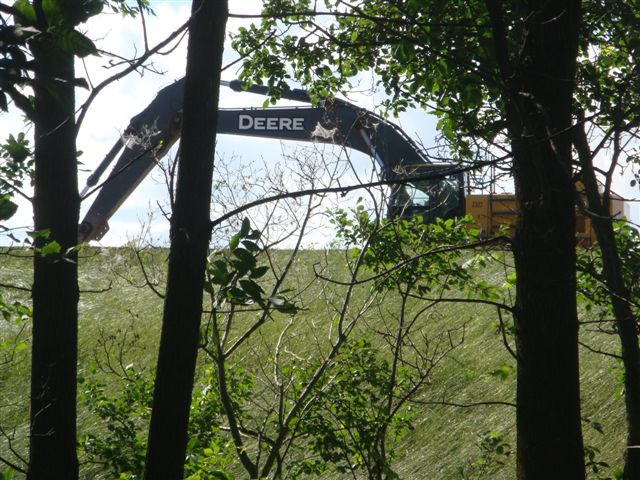 Barbara Sheldon’s farmland is located on the edge of Burlington, Ont., and is now walled in by a three-storey berm of dirt brought in by her neighbour, who owns the small Burlington Executive Airport next door. Barbara Sheldon’s farmland is located on the edge of Burlington, Ont., and is now walled in by a three-storey berm of dirt brought in by her neighbour, who owns the small Burlington Executive Airport next door.
She is worried about what might be in the muddy mix.
“We’re sitting ducks waiting for the contaminants to leach,” she said.
Sheldon told CBC’s Diana Swain that anyone in the country could face the same problem.
“They could lose everything. That is what happened to me. I lost everything,” she said.
“I’ve lost my property value. For five years I’ve lost the use of my land, I’ve lost the use of my home. I mean, from sun up to sun down and sometimes at night and on weekends we’re talking back-up beepers, we’re talking about dump trucks surrounding me,” Sheldon said.
Need for places to dump dirt will increase
Rural residents are angry that some landowners are taking in millions of dollars worth of soil dug up from Toronto-area construction sites with little oversight. The City of Toronto estimates nearly four million cubic metres of soil will be dug up in the next 10 years for Toronto water and transit projects alone.
With more and more soil being displaced to make room for condos, transit, Pan Am Games venues and other urban development projects, the need for places to dump that dirt is only going to increase.
Some municipalities have bylaws about using private property for landfill, but rules around soil testing and the amount of dirt that can be dumped are muddy.
Ontario environmental commissioner Gord Miller said it’s time for tougher rules as well as clarification on who has jurisdiction.
“We don’t have security on piles, on areas where we know there is contaminated soil … and it can be removed and sort of mixed in and how would we know? So there is legitimate concern when large volumes of soil are being deposited in rural areas with very little checking,” he said.
‘Disingenuously raising concerns’
Sheldon said every level of government she contacted for help since the dumping began five years ago said it wasn’t their responsibility.
 Court documents obtained by CBC News show Vince Rossi, owner of the Burlington Executive Airport, earned more than $855,000 accepting fill at the Burlington airport between the years 2011 to 2013. Court documents obtained by CBC News show Vince Rossi, owner of the Burlington Executive Airport, earned more than $855,000 accepting fill at the Burlington airport between the years 2011 to 2013.
In a statement to CBC News, Rossi accused his neighbours of “disingenuously raising environmental concerns.”
Rossi said the Ministry of the Environment has not found a problem with the fill he is using.
He also said that municipal bylaws don’t apply to his property.
“As for the issue of jurisdiction, our view is that only Transport Canada has a say over the nation’s airports,” he wrote.
The City of Burlington took the airport to court last year and got the dumping stopped. An appeal of that decision will be heard on June 11.
Similar disputes are playing out in other rural communities, like New Tecumseth in Simcoe County, which sits on the environmentally protected Oak Ridges Moraine about an hour north of Toronto.
A caravan of trucks began dumping dirt on the local air strip there four years ago, and concerned residents say they haven’t been able to get answers about what’s in the soil or the potential impact to well water.
Voluntary guidelines
Ontario’s Ministry of the Environment issued voluntary industry guidelines last year on testing and disposing of soil. But a report by the City of Toronto’s chief planner raises concerns that the guidelines do not deal with excess soil moved across jurisdictional boundaries.
“As a result, there continues to be a policy and regulatory gap in this area,” the report says.
Concerned citizens and environmental groups have formed the Ontario Soil Regulation Task Force, and are calling on the province to create an enforceable Clean Soil Act.
“That fill has to go somewhere. Somebody’s going to find a place for it, because it’s got money attached to it,” Sheldon said. “Until that money is removed from the fill, they should charge people. You want to put it here? OK, you pay us, developers. The whole system’s broken from the start.”
Miller, Ontario’s environmental commissioner, said to tackle the problem, you have to start at the source.
“The people who dig the holes should be responsible cradle to grave to making sure that soil is not only going somewhere where it’s safe, but somewhere where it’s wanted, and deposited in a manner that’s acceptable to the receiving municipality and the local residents,” Miller said.
The CBC is understood to be planning a series of television features on the problem. The natives north of Dundas will be beating their drums wildly tonight as they prepare for the appeal hearing tomorrow.

 By Pepper Parr By Pepper Parr
June10, 2014
BURLINGTON, ON The structure is majestic. The hallways are grand; the court rooms ooze of power and authority. The library is magnificent. Within the volumes on the shelves is the legal foundation of the province; the decisions the courts have issued which define us as a society that lives by the rule of law that is applied to everyone equally.
 View of Osgoode Hal;l from Queen Street West The building was named to honour of the province’s first chief justice, William Osgoode
It is here that maybe 20 or so people from Burlington will travel Tuesday morning to hear Ian Blue, QC argue the city’s side of an appeal made by Burlington Air Park Inc., against Justice John Murray’s earlier decision that the air park did have to comply with city bylaws, specifically the site alteration bylaw.
The six-acre (24,000 m²) site at the corner of Lot Street (Queen Street West today) and College Avenue (University Avenue today) was acquired by the Law Society in 1828. The original 2 1⁄2-storey building was started in 1829 and finished in 1832 from a design by John Ewart and W. W. Baldwin.
Between 1838 and 1843, the hall was turned into troop barracks. When the Law Society regained possession in 1844, an expansion was designed by Henry Bowyer Lane; the West Wing and Library were built, with two domes (later removed) over the library to connect the two wings.[5] In 1846 the Law Society entered into an agreement with the government to house the province’s Superior Court at the hall. Today, the building is jointly owned by the Law Society and the Government of Ontario.
 Main law library – there is another reserved for judges. 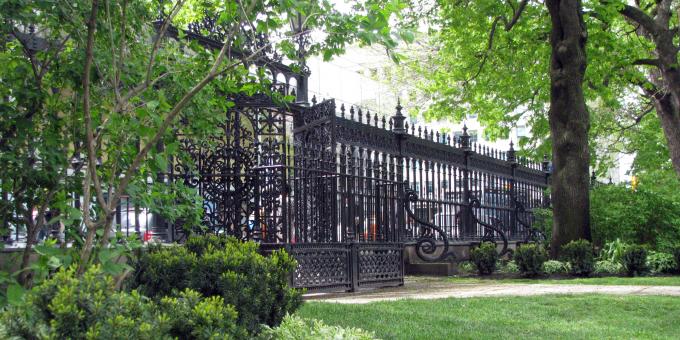 The belief once was that the wrought iron gates were put in place to keep cattle off the grounds. Not so – but the grounds are truly something to appreciate. Two libraries are housed within Osgoode Hall: the Great Library of the Law Society of Upper Canada and a smaller library for judges. The Great Library was designed by Cumberland and Storm (1857–1860) and features an ornate plaster ceiling, cork floors, and etched glass windows. A War Memorial by Frances Norma Loring (1887–1968), sculpted in 1928, was added to the Library in honor of Ontario lawyers and law students killed during the First World War. Behind the Great Library (and accessible through it) is the American Room, designed by Burke and Horwood in 1895, a more intimate room with a spiral staircase.
 A five judge appeal court panel. Ian Blue and Peter E. J. Wells will argue their case before a three member panel. There is the belief in the minds of some that this case will be appealed to the Supreme Court of Canada For those able to make the trip, I am reluctantly not with that crowd today, soak up the splendour of the setting and the history that literally pervades the walls and know that you are in a building where the rule of law prevails.
Be prepared for an experience.

 By Pepper Parr By Pepper Parr
June 8, 2104
BURLINGTON, ON.
Odd how things sometime work out.
Pat Moyle is driving home in his car, wife with him. He takes the call.
Burlington’s Mayor Rick Goldring is on the line.
 Pat Moyle believes he knows why Goldring is calling. Burlington needs a city manager – the one we had found that Calgary was more to his liking. Moyle had recently retired as the Chief Administrative Officer of Halton Region and he knew everyone over there with municipal administrative skills. Moyle thought Goldring was looking for some names of people that might be available as interim city managers until the municipal election is over and a new council is sworn in. Pat Moyle believes he knows why Goldring is calling. Burlington needs a city manager – the one we had found that Calgary was more to his liking. Moyle had recently retired as the Chief Administrative Officer of Halton Region and he knew everyone over there with municipal administrative skills. Moyle thought Goldring was looking for some names of people that might be available as interim city managers until the municipal election is over and a new council is sworn in.
Goldring wanted a little more than a recommendation –he wanted to be able to put Moyle’s name on a business card and have him serve as the interim city manager for as much as a year.
Apparently the Mrs. Moyle wasn’t ecstatic about the idea but Pat wasn’t taking to the Florida retirement stuff all that well – he still had harness he had not worn out and wanted to stay in the game. Pat said he would get back to Goldring but as one listened to Moyle explain the sequence this was a done deal.
Pat Moyle certainly knew what Burlington was all about – perhaps better than many at the “director level” in the city. He knew what the long term issues were, he was more than likeable and had worked with the top line people in the past. And he was certainly no slouch during the six years he served as the Regional CAO. This was going to be a good fit
Then there was that nice little $50,000 plus bonus for the city. Traditionally the municipal sector hires outside consultants who run an add and collect resumes. The tab fir that task comes in at around $50,000 each time.
The bonus for Burlington was that Moyle was going to be attending the annual meeting of the Canadian Association of Municipal Administrators, taking place just down the road in Niagara Falls. Moyle just took a bigger brief case and began to collect resumes – and get a clear sense as to who might find themselves wanting to move up the food chain and enjoy better beef.
Moyle might manage to clean up some of the problems at the city’s General Manager level as well.
That is the easy part of the job Pat Moyle took on as interim city manager. The rest of June is going to keep him humping. The Burlington Air Park appeal of Justice John Murray’s decision requiring the air park to comply with city bylaws will be heard next week. It will take a few months for a decision to work its way into the hands of the public but by the end of the appeal hearing the city will have a sense as to where this might go. Wise people do not attempt to think through how an appeal court might decide. The decision could be handed down right smack in the middle of the waning days of the municipal election.
There are some very positive upsides to the appeal court decision for the city. Once the legal problems are solved the city can get on with the business of getting it right for the rural part of the city. That may mean different ownership of the air park property.
Less than a week after the Air Park appeal is heard Moyle will have to take part in the mediation of just who owes what for the construction of the pier – which is about to celebrate its first official year of existence.
The median will stretch over several days at the end of which a settlement will have been reached or the case goes to trial. Going to trial would probably be the better thing for this council. At this point no one knows what each of the five parties wants from the other. The numbers get put on the table the first day – which is when jaws we are told will drop.
The financial and emotional damage done to Harm Schilthuis and Sons Ltd., (HSS) has been absorbed – now they want their money and an apology that will make the past four years easier to have had to live with just a little easier.
When Jeff Fielding was managing the financial and legal side of the pier file he frequently used the phrase “everyone is going to have to give a little”. Fielding had a way at times of being very persuasive – but Jeff Fielding is no longer on the city payroll and his approach won’t work without him.
Moyle is for the most part on his own with a legal team that no longer has an upper hand. HSS is very clear on want they want; AECOM, the project managers have always been in this for the long haul. PV&V , an insurance brokerage may not have to pay a price for siding with someone other than their client. But it is the city that stands to lose the most.
If there is a settlement the public is going to want to know how much the city settled for – and that isn’t a number they will want to put on the table – so the city ensures that a gag order is included in the minutes of settlement.
 Steel re bar being put in place on the pier deck for the second time. First attempt got stripped back to the original beams But if HSS digs in their heels and demands that they finally get paid and be given the level of apology they feel they deserve – and they are the ones who have been trashed by most members of this city council and gotten by without payment of invoice that were approved for payment for more than three years – then the city has a tough one in front of them. The days of everyone having to give a little are long gone.
Assuming the pier becomes a campaign issue – and it should – there is an opportunity for every Councillor and the Mayor to reflect on what they could have done differently
Pat Moyle has been with us as interim city manager barely month – he might be a significantly different man by the end of June. The Senior management team he leads might be quite a bit different before he turns in his keys as well. We got lucky with Moyle and if the idea to sound him out was Mayor Goldring’s – great, finally, some leadership.

 By Ray Rivers By Ray Rivers
June 6, 2014
BURLINGTON, ON
There was no winner in the debates this week, there rarely ever is. Premier Wynne got nailed by the gas plant fiasco as a first question, though she must have known it was coming. I suppose there is no good answer, so an apology and a promise that it won’t happen again will have to suffice.
 The debate was far from her greatest moment -what was with the constant apologizing? In hindsight the gas plant locations were a mistake – every other political party would have cancelled the construction locations.. As the Editorial Board of the Globe and Mail has noted, the deficit and debt are not a crisis for Ontario – what I said last week. In addition, Ontario has the lowest cost public service (per capita) in all of Canada. So Hudak’s plans are over the top and wrong-headed. Killing one hundred thousand public service jobs , plunging the economy into recession and crippling our social programs, including health care and education, will not create his illusionary million jobs – quite the opposite. It was remarkable to hear him actually brag about his math skills, given that every reputable economist consulted has called the numbers in his plan rubbish.
 The leader of the party without a platform managed to force an election that wasn’t needed and has yet to understand what corruption is. Add to that getting lost on the way to significant pension reform and you get – leadership? Hudak claims that high energy prices are the reason investment in Ontario is faltering. But he has conveniently forgotten about his days sitting at the Harris/Eves government table, when Ontario Hydro was broken up, expensive contracts given to the private sector and multiple costly agencies created to do what Hydro had once done better. Electricity rates started going through the roof until Eves subsidized electrical bills, adding this to the very debt Hudak now rightly criticizes. In all its cost-cutting the Harris government delayed maintenance of the province’s electrical grid causing brown-outs and contributing to the big blackout in 2003.
And Bob Rae and NDP’s interference in the operations of Ontario Hydro were part of the reason Mike Harris decided to irreversibly break up the agency in the first place. Having said all of that, McGuinty had almost a decade to rectify the mess he inherited and although he has restored system reliability and shut down the dirty coal plants, the energy rates have risen and they won’t be coming down soon, regardless who wins the election. Neither the Tories nor the NDP have any more credibility on this file than the Liberals.
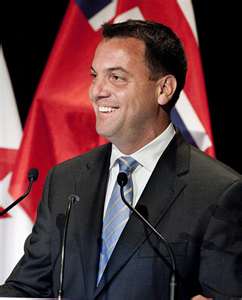 It didn’t matter how error filled the Million Jobs Plan was – Hudak just plowed right through the facts – the same thing Mike Harris did with his common sense revolution – which we are still paying for.
The province has two very very significantly different futures for us to choose from. June 12th is going to be a long night.
 Ray Rivers writes weekly on both federal and provincial politics, applying his more than 25 years as a federal bureaucrat to his thinking. Rivers was a candidate for provincial office in Burlington where he ran against Cam Jackson in 1995, the year Mike Harris and the Common Sense Revolution swept the province. He developed the current policy process for the Ontario Liberal Party. Ray Rivers writes weekly on both federal and provincial politics, applying his more than 25 years as a federal bureaucrat to his thinking. Rivers was a candidate for provincial office in Burlington where he ran against Cam Jackson in 1995, the year Mike Harris and the Common Sense Revolution swept the province. He developed the current policy process for the Ontario Liberal Party.
Background links:
Debates More Debates Globe and Mail Editorial Opposition Gas Plant Promise

 By Pepper Parr By Pepper Parr
June 5, 2014
BURLINGTON, ON.
First it was the provincial election debate, then it was the Stanley Cup games, now it’s the Meltdown in Moncton and with the cup still not won yet – hockey is back in the picture.
Tough for a small town like Burlington to get any air time on national television but it appears that the he CBC National News program on air park problems across Ontario and the Burlington Air Park In., in particular will now be a multi-part effort that will run over a period of time.
The CBC News crew was on site last week recording the damage done, as well as the pristine view the owner of one Appleby Line used to have.
 The purpose of the series is to take a look at just what has been happening across the province where small air parks are using their sites to dump fill on – the premise being that they are “improving” their property which they claim is not subject to municipal bylaws but only the dictates of the federal aeronautics legislation. The purpose of the series is to take a look at just what has been happening across the province where small air parks are using their sites to dump fill on – the premise being that they are “improving” their property which they claim is not subject to municipal bylaws but only the dictates of the federal aeronautics legislation.
The situation with the air park in Burlington is a little more advanced than it is in other municipalities. The city won its first court case, which has been appealed and will be heard June 11.
Ian Blue, the lawyer retained by the city to argue the appeal, will be on the air for part of the series which at this point in time is scheduled for June 10th – but every Canadian knows that when the Stanley Cup playoffs are taking place – everything has to adjust that that schedule.
In a note the area residents CBC said: “This is a heads-up to inform you that I have been advised that CBC National News will be airing a report on the fill operations currently underway at various airparks in Ontario – including the Burlington Airpark – and the impacts these have had on the local citizens and the environment.”
They plan to lead the story with footage of the citizens’ rally planned for tomorrow at the Volk Airpark near Tottenham.
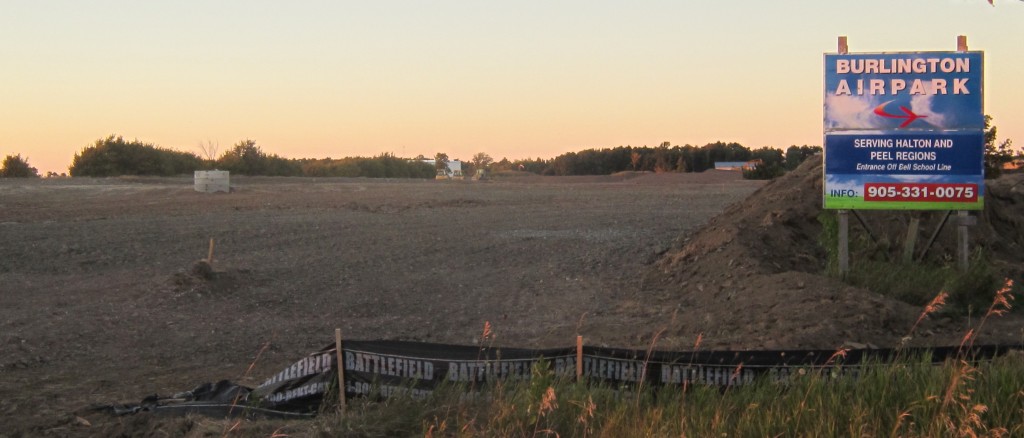 It might take more than a year for the problems with the air park to get resolved – but the noose is now getting tighter and tighter. The city and its citizens along with the hundreds of pilots who make legitimate use of the runways now need to begin thinking what could and should be done with that 200 acres of land. Properly approached by a developer that is prepared to follow the rules and adjust to changing conditions. The end game will soon be upon us. The story was scheduled to be aired Wednesday June 4th, but that got bumped)
CBC had planned to roll them out on Wednesday but The National’s lineup is heavy and the show is delayed because of hockey so we’re holding it until next week.
CBC added that ”we were only able to skim the surface of some of the issues in this first bit of coverage, and there are many issues we’ve either not yet touched on, or have not had time to fully explain. We plan to keep looking into various issues and story lines that came up over the course of gathering elements for this initial coverage, so I will likely be back in touch again in the near future with more questions.”
Burlington is finally going to get coverage of a critical community event from an organization that has much more in the way of resources than the Gazette will ever have.

 By Pepper Parr By Pepper Parr
May 30, 2014
BURLINGTON, ON.
While the CBC News crew was doing its interview on the Sheldon property on Appleby Line, construction equipment and work crews along with what were believed to be crew managers were seen.
Once it became evident to them that camera crews were on the property filming they retreated but the equipment remained on the site
There is a very solid community in north Burlington that watches what goes on like a bunch of hawks. Their objective is to document and photograph as much as they can; including run off from the air park site where tonne upon tonne of partially inspected fill was dumped without the required sit plan alteration permit.
A Superior Court judge has ruled that the air park must comply with municipal bylaws. Burlington Air Park Inc., has appealed that decision. The appeal will be heard in Toronto June 11, 2014
 Appleby Line property owner does a CBC News interview with view of the landfill dumped without a site alteration permit.  Construction crews skulk away in the background. They appeared not to be available for an interview. 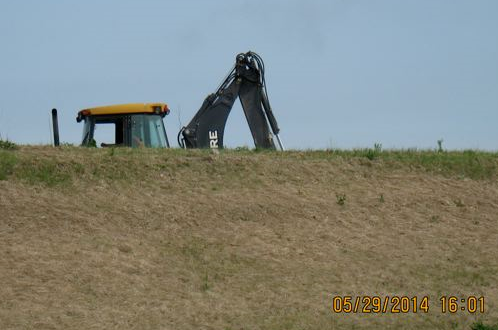 Construction crews continue their work just out of site of news camera crews. 
 By Pepper Parr By Pepper Parr
May 29, 2014
BURLINGTON, ON
On the night that the Montreal Canadiens were showing North America that they really knew how to play the game by beating the New York Rangers 7-4 – 175 sports people took part in the Burlington Sports Hall of Fame 2014 Inductee event. (Two night later the Habs lost the game and the semi-final series.)
Mayor Rick Goldring presented a certificate with a pin from Council to Jesse Lumsden in recognition of his participation in the 2014 Olympic Winter Games.
The inductees were – Dr Frank Hayden, Ken and Elaine Lake – long time track and field officials, Jesse Lumsden – Olympic Bobsledder – former football player and Nelson grad and Melanie McKay – Olympic Swimmer
 Elaine and Ken Lake – tireless workers. Elaine and Ken officiated in Edmonton at the World Outdoor Championships, at the Vancouver Commonwealth (1994), at the PAN AM Junior in Windsor, at the World Junior in Charlettown, and finally in Toronto at the 2012 World Athletics Deaf Championships.
At the NOC Level, Elaine served as Vice Chair for Human resources for six years, and when she left in 1992, she passed the position on to Ken. Both performances have been excellent and most of their work is still applied today. At the provincial Level, Elaine served as the Ontario Officials’ Council Chair for 1977 -78 while Ken covered the same position during 1984-85. In addition, Ken acted as OOC’s Vice Chair, Evaluator and Clinician, and member of the Provincial Test.
Lance Nethery – NHL Hockey Player – is currently CEO of the Cologne Sharks in the German Hockey League. Centre Lance Nethery played 41 NHL games during the early ’80s. He was a fine goal scorer who put up impressive numbers in college, the minors, and European leagues.
The Toronto native scored 91 goals in four seasons at Cornell University. After scoring 32 times in 29 games, he was chosen 131st overall by the New York Rangers in 1977. He was named to the ECAC first all-star team twice and the second team once and was a two-time selection to NCAA east first all-American team.
During the 1979-80 season Nethery adjusted well to the pros by scoring 62 points for the New Have Nighthawks of the AHL. He was called up by the Rangers in 1980-81 and scored 23 points in 33 games but eventually lost out to centres Mike Rogers, Mark Pavelich, Mike Allison, and Robbie Ftorek.
Nethery began the 1981-82 season on Manhattan but was returned to the minors then traded to the Edmonton Oilers for veteran goalie Eddie Mio. He played three games in Edmonton but spent most of his time with the CHL’s Wichita Wind where he scored 35 goals in only 46 contests. He battled injuries in 1982-83 before joining the HC Davos club of Switzerland the next year. Nethery was a dominant scorer for his new club and led the Swiss League with 46 goals in 1985-86. He retired in 1988 after leading Davos to two Swiss Elite League championships.
Mayor Goldring added in a comment later that he and Lance are the same age – went to school together from Kindergarten or Grade 1 to Grade 13 – two Nelson Grads. “We played on the same house league team when we were eight. One of my more vivid memories is scoring my first goals in organized hockey with Lance being the first to congratulate me.”
 Jesse Lumsden – set records that have yet to be broken. JESSE LUMSDEN: is a hometown boy who loved to play all kinds of sports. But his passion was football and he was good – so good in fact that in 2004 this former McMaster Marauder was awarded the HEC CRIGHTON trophy recognizing the most outstanding collegiate football player in Canada. In the same year Jesse was honoured by the CIS as not just the best football player in the country but the best university ATHLETE in the country.
Jesse followed in the footsteps of his father Neil who had an accomplished career at the University of Ottawa and ten remarkable years in the CFL. 2014 is a memorable year for this father-son team. Later this year Neil will be inducted into the Canadian Football Hall of Fame while his son is recognized now in his hometown as a member of the Burlington Sports Hall of Fame.
Jesse earned football prominence very early in his Nelson High School career. He captained the 1999 Nelson Lords to an undefeated season, earning a trip to the Metro Bowl played in Toronto’s Skydome. A clear underdog, Nelson defeated a bigger and much older Toronto Central Tech team to win the provincial title. This gifted running back was named the game’s MOST VALUABLE OFFENSIVE PLAYER AWARD and a Greater Toronto Area All-Star.
Heavily recruited, Jesse selected McMaster where he made an immediate impact. He electrified spectators (and coaches too) with his speed and elusiveness. In his third year he broke the single season O.U.A. rushing mark gaining a remarkable 1497 yards and averaging 8.4 yards per carry. He also tied the single season touchdown record with 20. His sensational season earned the Nelson grad McMaster’s Male Athlete of the Year. In his senior season he continued to tear up the turf rushing for 1816 yards – averaging 10.2 yards per carry and establishing a record 21 touchdowns. He was named OUA 1st Team All-Star and CIS All-Canadian and he repeated as Mac’s Athlete of the Year
As a young man Jesse dreamt about playing pro ball in the NFL. Even though drafted in 2004 in the first round by the Hamilton Tiger Cats he was drawn south of the border where he signed as a free agent with the NFL’s Seattle Seahawks. The Cats hoped he would return to Tigertown. And he did. Jesse had an incredible rookie season and earned a spot as an Eastern all-star. Injuries short-circuited the talented young man’s six year CFL career.
This gifted athlete recently turned his athleticism to bobsledding. Recognized as one of the top brakemen in the world, the Nelson grad has twice worn the Canadian singlet on the world stage at the 2010 and 2014 Olympic Games. Today we recognize his football talent and welcome “hometown hero” – Jesse Lumsden – to the Burlington Sports Hall of Fame.
DR. FRANK HAYDEN: Frank Hayden had a high school named after him but before that he was a major moving force in the creation of what was first known as the Special Olympics.
A pioneer sets out to explore and find new territory. He/she must have vision but along with this rare quality must come perseverance, tenacity and diligence. Dr. Frank Hayden displayed these qualities and much more in his quest to provide sporting opportunities for those who are developmentally disabled and intellectually challenged.
 Frank Hayden with Ontario Lt Governor after receiving the Order of Ontario In the early sixties, testing of children with intellectual disabilities revealed that they were only half as physically fit as their non-disabled peers. It was assumed that their low fitness levels were a direct result of their disability. Dr. Hayden questioned this assumption. He conducted research which concluded that, given the opportunity, intellectually disabled people could become physically fit, and acquire the physical skills necessary to participate in sport.
His belief and understanding led him to conceive the idea of Special Olympics, a national sports program for people with an intellectually disability. His proposal was originally rejected by the Canadian government, however, his research became known to the Joseph P. Kennedy Foundation in Washington D.C. So he went to work with Eunice Kennedy Shriver for the next seven years. Here he served as Director at the Kennedy Foundation and was the catalyst in establishing federal legislation to assist persons with a disability.
He returned to Canada and worked to establish a similar program here. Canada’s first games were held in Toronto in 1969 with 1400 athletes. In 1975 and assumed the position of Director of the School of Physical Education and Athletics at McMaster. From there Dr. Hayden persisted with his dream and established the Special Olympics Office of International Development , assisting with the growth of International programs from 15 to 50.
His list of achievements and awards is remarkable. Here are a few: Honorary Member of the Canadian Olympic Association; Officer of the Order of Canada in 1999 and Order of Canada in 2000. Also, he was recognized recently by the Halton Board of Education as the name of their newest and ‘state of the art’ secondary school here in Burlington is Frank Hayden High School. Dr. Hayden legally incorporated “Special Olympics Inc.” and today the program provides training and competition for more than three million athletes in more than 170 countries.
Olympic swimmer Melanie McKay was also recognized and inducted into the Burlington Sports Hall of Fame. A biography of Ms McKay was not available.

|
|
 By Pepper Parr
By Pepper Parr














 By Ray Rivers
By Ray Rivers


 ne 20, 2014
ne 20, 2014
 By Pepper Parr
By Pepper Parr





 By Pepper Parr
By Pepper Parr
 Given not only the principles involved but also the amount of money on the table and a 200 acre piece of land – it is reasonable to conclude that this is far from over.
Given not only the principles involved but also the amount of money on the table and a 200 acre piece of land – it is reasonable to conclude that this is far from over. Dermetics registered 10 memberships with Woman Who Care. This allows 10 of their staff to attend the meetings where they participate fully – as if they were funding their donation themselves however Dermetics will write the cheque to the recipient organization.
Dermetics registered 10 memberships with Woman Who Care. This allows 10 of their staff to attend the meetings where they participate fully – as if they were funding their donation themselves however Dermetics will write the cheque to the recipient organization.  By Staff
By Staff
 By Ray Rivers
By Ray Rivers

 By Pepper Parr
By Pepper Parr

 By Pepper Parr
By Pepper Parr

 By Pepper Parr
By Pepper Parr
 By Pepper Parr
By Pepper Parr Barbara Sheldon’s farmland is located on the edge of Burlington, Ont., and is now walled in by a three-storey berm of dirt brought in by her neighbour, who owns the small Burlington Executive Airport next door.
Barbara Sheldon’s farmland is located on the edge of Burlington, Ont., and is now walled in by a three-storey berm of dirt brought in by her neighbour, who owns the small Burlington Executive Airport next door. Court documents obtained by CBC News show Vince Rossi, owner of the Burlington Executive Airport, earned more than $855,000 accepting fill at the Burlington airport between the years 2011 to 2013.
Court documents obtained by CBC News show Vince Rossi, owner of the Burlington Executive Airport, earned more than $855,000 accepting fill at the Burlington airport between the years 2011 to 2013. By Pepper Parr
By Pepper Parr



 Pat Moyle believes he knows why Goldring is calling.
Pat Moyle believes he knows why Goldring is calling.



 Ray Rivers writes weekly on both federal and provincial politics, applying his more than 25 years as a federal bureaucrat to his thinking.
Ray Rivers writes weekly on both federal and provincial politics, applying his more than 25 years as a federal bureaucrat to his thinking.



 By Pepper Parr
By Pepper Parr






